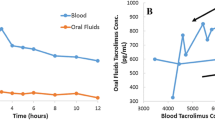Abstract
The aim of this study was to investigate whether a strong and clinically applicable correlation exists between saliva and whole-blood tacrolimus levels measured by high-performance liquid chromatography-tandem mass spectrometry. A high degree of correlation would potentially allow pain-free saliva sample collection to replace blood sampling for the measurement of tacrolimus levels. Enrolled in the study were 37 children (24 boys) aged 8–18 years [median (IQR) 16.2 (12.9–17.5) years] attending the renal transplant clinic at the Royal Manchester Children’s Hospital and 77 paired blood saliva samples were collected. The mean (SD) saliva tacrolimus level was 0.14 (0.16), range 0–0.7 μg/l. In ten cases, tacrolimus was not detected in the saliva despite being present in blood. The ratio of blood-to-saliva tacrolimus levels varied from 2.6 to 550. The Pearson product-moment correlation suggested a weak linear relationship between tacrolimus levels in blood and saliva with a coefficient 0.36. Individual patients did not demonstrate consistent tacrolimus blood/saliva ratios with a mean correlation of 0.08. Additional experiments excluded saliva contamination with blood and sample collection and storage conditions as causes of poor correlation. The measurement of saliva tacrolimus levels in place of or as an adjunct to blood sampling therefore cannot be recommended.



Similar content being viewed by others
References
Webb NJA, Roberts D, Preziosi R, Keevil BG (2005) Fingerprick blood samples can be used to accurately measure tacrolimus levels by tandem mass spectrometry. Pediatr Transplant 9:729–733
Selinger D, Simmins S, Hailer AW, Nurnberger JI Jr, Gershon ES (1982) An effective method for measuring slivary lithium on anticholinergic drugs. Biol Psychiatry 17:1145–1155
Tokugawa K, Ueda K, Fujito H, Kurokawa T (1986) Correlation between the saliva and free serum concentration of phenobarbital in epileptic children. Eur J Pediatr 145:401–402
Rylance GW, Butcher GM, Moreland TA (1977) Letter: saliva carbamazepine levels in children. Br Med J 2:1481
Horning MG, Brown L, Nowlin J, Lertratanangkoon K, Kellaway P, Zion TE (1977) Use of saliva in therapeutic drug monitoring. Clin Chem 23:157–164
Schmidt D, Kupferberg J (1975) Diphenylhydantoin, phenobarbital, and primidone in saliva, plasma, and cerebrospinal fluid. Epilepsia 16:735–741
Mendonza A, Gohh R, Akhlaghi F (2004) Determination of cyclosporine in saliva using liquid chromatography-tandem mass spectrometry. Ther Drug Monit 26:569–575
Mendonza AE, Gohh RY, Akhlaghi F (2006) Analysis of mycophenolic acid in saliva using liquid chromatography tandem mass spectrometry. Ther Drug Monit 28:402–406
Filler G, Grygas R, Mai I, Stolpe HJ, Greiner C, Bauer S, Ehrich JH (1997) Pharmacokinetics of tacrolimus (FK 506) in children and adolescents with renal transplants. Nephrol Dial Transplant 12:1668–1671
Keevil BG, McCann SJ, Cooper DP, Morris MR (2002) Evaluation of a rapid micro-scale assay for tacrolimus by liquid chromatography-tandem mass spectrometry. Ann Clin Biochem 39:487–492
Shaefer MS, Collier DS, Haven MC, Langnas AN, Stratta RJ, Donovan JP, Sorrell MF, Shaw BW Jr (1993) Falsely elevated FK-506 levels caused by sampling through central venous catheters. Transplantation 56:475–476
Rylance GW, Moreland TA (1980) Drug level monitoring in paediatric practice. Arch Dis Child 55:89–98
Mucklow JC, Bending MR, Kahn GC, Dollery C (1978) Drug concentration in saliva. Clin Pharmacol Ther 24:563–570
Kino T, Hatanaka H, Miyata S, Inamura N, Nishiyama M, Yajima T, Goto T, Okuhara M, Kohsaka M, Aoki H, Ochiai T (1987) FK-506, a novel immunosuppressant isolated from a Streptomyces. II. Immunosuppressive effect of FK-506 in vitro. J Antibiot (Tokyo) 40:1256–1265
Svensson CK, Woodruff MN, Baxter JG, Lalka D (1986) Free drug concentration monitoring in clinical practice. Rationale and current status. Clin Pharmacokinet 11:450–469
Wood JH, Flora KP, Narasimhachari N, Baker CA (1982) Dependence of salivary drug concentration on salivary flow rate. Methods Find Exp Clin Pharmacol 4:255–260
Uematsu T, Yamaoka M, Matsuura T, Doto R, Hotomi H, Yamada A, Hasumi-Nakayama Y, Kayamoto D (2001) P-glycoprotein expression in human major and minor salivary glands. Arch Oral Biol 46:521–527
Kragelund C, Hansen C, Torpet LA, Nauntofte B, Brøsen K, Pedersen AM, Buchwald C, Therkildsen MH, Reibel J (2008) Expression of two drug-metabolizing cytochrome P450-enzymes in human salivary glands. Oral Dis 14:533–540
Acknowledgements
This study was funded by an unrestricted educational grant from Astellas Pharma Ltd. and supported by the NIHR Manchester Biomedical Research Centre. The authors would like to thank Drs. Nick Plant and Mohan Shenoy and Sister Denise Roberts, who contributed patients to the study. We are also grateful to the nursing staff in the outpatient department for collecting the blood samples, and the children and young adults who participated in the study. Further thanks are extended to Dr. Iain MacPhee of St. Georges Hospital, London, and Dr. Nas Undre of Astellas Pharma Ltd., who kindly reviewed the manuscript.
Author information
Authors and Affiliations
Corresponding author
Rights and permissions
About this article
Cite this article
Belostotsky, V., Adaway, J., Keevil, B.G. et al. Measurement of saliva tacrolimus levels in pediatric renal transplant recipients. Pediatr Nephrol 26, 133–138 (2011). https://doi.org/10.1007/s00467-010-1670-3
Received:
Revised:
Accepted:
Published:
Issue Date:
DOI: https://doi.org/10.1007/s00467-010-1670-3




